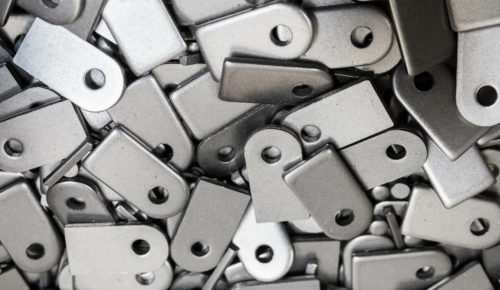Advanced Techniques in Metal Stamping for Accuracy Manufacturing
In the realm of precision manufacturing, the advancement of metal stamping methods has been a critical force in attaining exceptional levels of accuracy and efficiency. As sectors continuously require better tolerances and detailed layouts in their metal elements, the quest for advanced methods in metal marking has magnified. From the utilization of innovative multi-stage marking procedures to the assimilation of advanced automation modern technologies, the landscape of metal marking is going through an extensive makeover. In this vibrant field, the convergence of technology and precision is improving the opportunities of what can be accomplished in steel construction.
Advanced Multi-Stage Stamping Procedures
Going over the ins and outs of sophisticated multi-stage stamping processes exposes the innovative strategies utilized in modern-day manufacturing methods. Metal Stamping. Multi-stage stamping is a complex procedure that includes multiple steps to change a flat sheet of steel right into a last stamped product. The usage of modern dies, where various operations are executed at each stage of the stamping process, enables high precision and efficiency in the manufacturing of elaborate metal components
Throughout the preliminary phases of multi-stage marking, the flat metal sheet is fed right into the stamping press, where a collection of dies are utilized to reduce and form the product. Subsequent phases include additional creating, bending, and punching operations to more fine-tune the part. Each phase is thoroughly developed to build on the previous one, bring about the production of complex geometries with tight resistances.
Advanced multi-stage marking processes call for a high degree of experience and precision to ensure the high quality and uniformity of the stamped parts. By utilizing advanced machinery and tooling, producers can create a broad variety of metal parts with performance and accuracy.
Accuracy Tooling Innovations
Precision tooling developments have revolutionized the steel marking sector, enhancing performance and top quality in making procedures. CNC systems allow for intricate layouts to be equated straight into tooling, ensuring accuracy and repeatability in the stamping procedure.
Furthermore, the integration of sensing units and real-time monitoring capacities in accuracy tooling has actually allowed makers to identify and attend to issues promptly, reducing downtime and lowering scrap rates. By integrating wise innovation right into tooling, drivers can optimize criteria such as pressure, speed, and alignment during the stamping operation, resulting in enhanced product quality and boosted productivity.

Automation in Steel Stamping
The evolution of precision tooling technologies in the metal stamping industry has actually led the way for significant innovations in automation, changing the production landscape towards raised performance and performance. Metal Stamping. Automation in steel stamping involves making use of sophisticated equipment and robotics to do different tasks typically executed by human drivers. This change towards automation offers countless advantages, including enhanced precision, much faster manufacturing cycles, and decreased labor expenses
One key facet of automation in metal stamping is the execution of computer numerical control (CNC) systems, which make it possible for specific control over the stamping procedure. CNC modern technology permits the development of facility and detailed steel get rid of constant quality. Additionally, automated systems can be set to run continually, leading to greater outcome prices and shorter preparations.
In addition, automation boosts work environment safety by reducing hands-on handling of hefty products and minimizing the threat of accidents (Metal Stamping). As making sectors remain to accept automation, the future of metal marking holds fantastic promise for even greater effectiveness and development
High-Speed Stamping Methods

One of Click Here the key benefits of high-speed marking methods is the ability to generate a huge volume of components in a much shorter amount of time compared to typical stamping techniques. This enhanced performance not just enables manufacturers to satisfy limited production target dates yet likewise makes it possible for cost savings through economic situations of scale. Furthermore, high-speed marking can help in reducing material waste by enhancing the product usage throughout the stamping process.
In addition, high-speed marking techniques usually include Clicking Here ingenious attributes such as quick die change systems and real-time monitoring capabilities, even more boosting the overall efficiency and flexibility of the steel marking process. As modern technology continues to advancement, high-speed stamping is expected to play an essential role in driving the future of precision production.
Quality Control in Stamping Operations
Reliable quality assurance procedures are crucial for making certain the integrity and consistency of steel marking procedures. Quality control in marking operations entails a collection of methodical processes targeted at detecting and stopping issues in the produced parts. One vital aspect of quality control in metal stamping is making use of advanced examination methods such as optical evaluation systems and coordinate measuring makers (CMMs) to validate the measurements and resistances of stamped components.
In addition, quality assurance measures in marking procedures commonly consist of the execution of analytical process control (SPC) methods to monitor the production procedure in real-time and make certain that it remains within appropriate restrictions. By analyzing data and identifying patterns, makers can proactively address any kind of variances from the desired high quality standards.
Moreover, quality control in steel marking operations additionally involves extensive material screening to ensure that the raw products made use of fulfill the called for specifications for the stamping process. This might consist of carrying out product hardness examinations, tensile toughness examinations, and dimensional evaluations to ensure the high quality and stability of the stamped elements. Read Full Report In general, applying durable quality assurance measures is crucial for achieving top quality stamped parts regularly.
Final Thought
To conclude, progressed techniques in metal stamping play a critical role in precision manufacturing processes. With multi-stage stamping processes, cutting-edge tooling remedies, automation, high-speed strategies, and rigorous high quality control procedures, manufacturers can achieve greater levels of accuracy and effectiveness in their operations. These developments in steel marking technology have actually made it possible for business to create complex get rid of limited resistances, eventually bring about enhanced product top quality and client fulfillment in the production industry.